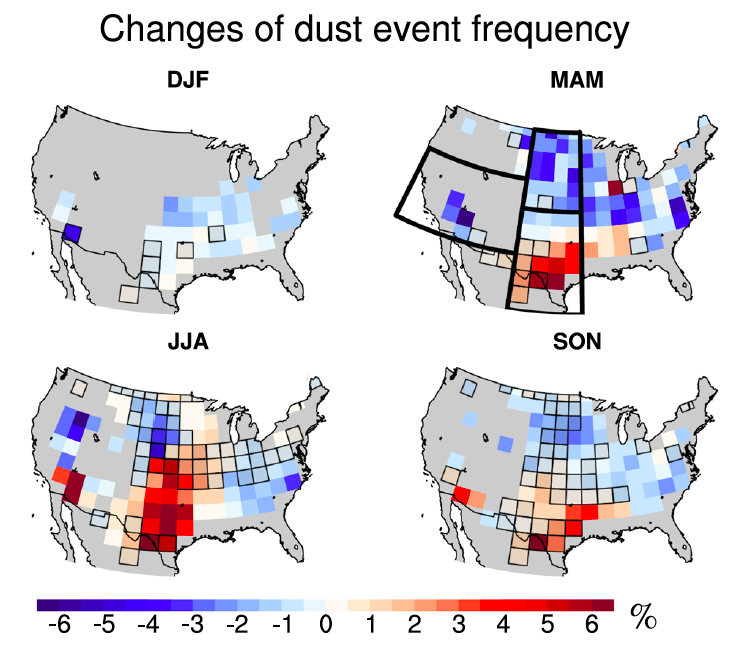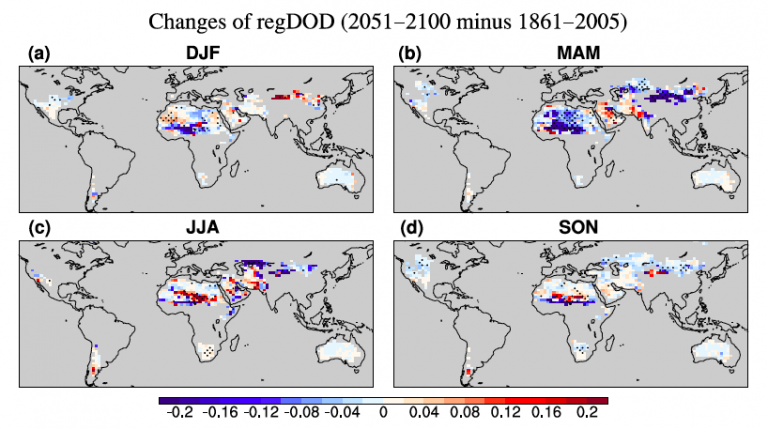Dust Emissions and Transport
Pacific Decadal Oscillation (PDO) and Springtime Dust Activities in Syria
A significant negative correlation is found between the Syrian dust optical depth (DOD) and the PDO in spring.

High DOD in spring is associated with lower geopotential height over the Middle East, Europe, and North Africa, accompanied by near-surface anomalous westerly winds over the Mediterranean basin and southerly winds over the eastern Arabian Peninsula. A negative PDO not only creates circulation anomalies favorable to high DOD in Syria but also suppresses precipitation in dust source regions over the eastern and southern Arabian Peninsula and northeastern Africa. (The impact of the Pacific Decadal Oscillation on springtime dust activity in Syria)
Climatic Factors Affect the Dustiness in the U.S.
Overall dustiness in the U.S. in the recent decade are largely associated with the variations of precipitation, soil bareness, and surface winds speed. (Projection of American dustiness in the late 21st century due to climate change)

In addition to the above factors, we found variations in surface fine dust (with an aerodynamic diameter of less than 2.5 μm) concentrations are associated with convective parameters such as convective inhibition (CIN) and convective available potential energy (CAPE) that reveal the stability of the atmosphere. The recent increase of fine dust concentration (1990-2015) in the southwestern US in spring is associated with precipitation deficit, whereas the increase in fine dust over the central Great Plains in summer is largely associated with increased atmospheric stability due to surface drying and lower troposphere warming. (Climatic factors contributing to long-term variations in surface fine dust concentration in the United States)

Future dust projections
Using multi-model output under the Representative Concentration Pathways (RCP) 8.5 scenario, we project that climate change will increase dust activity in the southern Great Plains from spring to fall in the late half of the twenty-first century – largely due to reduced precipitation, enhanced land surface bareness, and increased surface wind speed. Over the northern Great Plains, less dusty days are expected in spring due to increased precipitation and reduced bareness. (Projection of American dustiness in the late 21st century due to climate change)

Projections of DOD change in the late half of the 21st century under the RCP 8.5 scenario by CMIP5 multi-model mean is compared with a projection using both model output and observational constraints. Despite the uncertainties associated with both projections, results show some similarities between the two, e.g., DOD pattern over North Africa in DJF and JJA, an increase in DOD in the central Arabian Peninsula in all seasons, and a decrease over northern China from MAM to SON. (How reliable are CMIP5 models in simulating dust optical depth?)

Model validation and improvement
Seven CMIP5 models using interactive dust emission schemes are examined, and it is found that the multi-model mean can largely capture the global spatial pattern and zonal mean of DOD over land in present-day climatology in MAM and JJA. Seasonal cycle, magnitude, and spatial pattern are generally captured over major dust source regions such as North Africa and the Middle East, but less well represented in South Africa and Australia. Interannual variations in DOD are not captured by most of the models or by the multi-model mean. The constraints from surface bareness are largely underestimated, while the influences of surface wind and precipitation are overestimated. (How reliable are CMIP5 models in simulating dust optical depth?)

Seasonal dust prediction
The potential of seasonal dust prediction in the United States using an observation‐constrained regression model and key variables predicted by a seasonal prediction model developed at National Oceanic and Atmospheric Administration Geophysical Fluid Dynamics Laboratory, the Forecast‐Oriented Low Ocean Resolution (FLOR) model, is examined. Our method shows skillful predictions of spring dustiness 3 to 6 months in advance. (Seasonal Prediction Potential for Springtime Dustiness in the United States)
